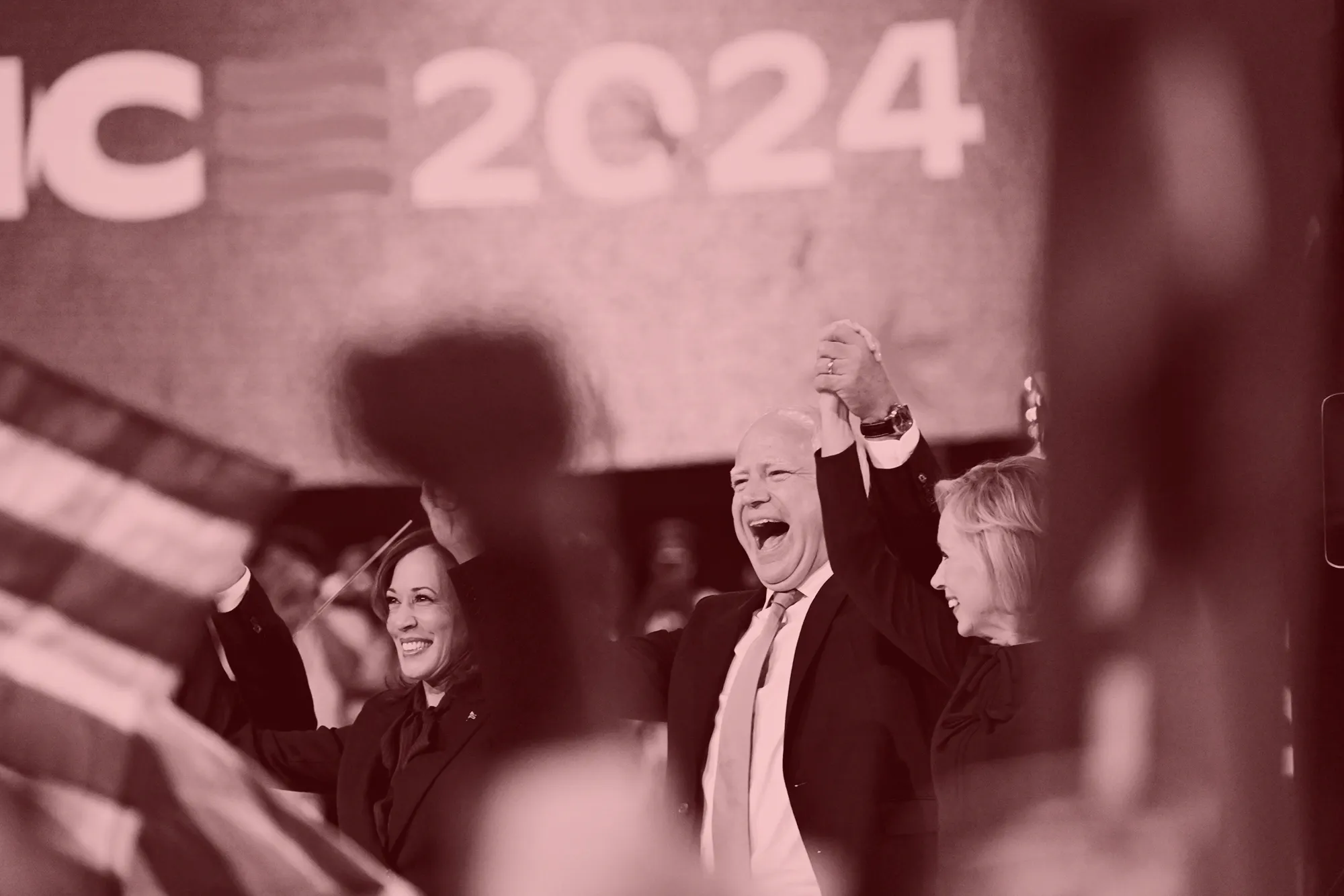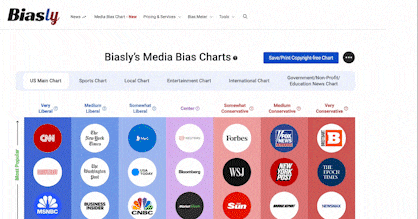
Vanity Fair is a prominent American magazine, which delves into a mix of popular culture, fashion, and current affairs. First appearing in 1859 and relaunched in its modern form in 1983, the magazine has a rich history of influencing cultural discussions and providing deep dives into various topics, ranging from celebrity interviews to political analysis.
The magazine is known for its sophisticated tone and high-quality content, including well-known photographic spreads and in-depth reportage. Vanity Fair has expanded its reach globally with editions in several countries, further solidifying its impact on international media and culture.
As a leading digital and print magazine with a reputation for some quality journalism with other, more sensationalist pieces throughout, the question of whether Vanity Fair is biased demands close examination.

Source: Pew Research Center
In this article, we will analyze the newspaper’s coverage and editorial decisions to determine if there is a discernible political bias in their reporting. Through our analysis, we hope to provide a comprehensive answer to whether The Vanity Fair is biased and shed light on the factors that contribute to media bias in general.
How Does Biasly Rate News Sources?
Biasly’s algorithms produce bias ratings to help provide multiple perspectives on given articles. Biasly has analyzed 200,000+ news articles from more than 3,200 news sources through our A.I. technology and team of political analysts to find the most factual, unbiased news stories.
Biasly determines the degree of political bias in news sources by using Biasly’s Bias Meter Rating, in which Biasly’s team analyzes media sources’ reliability and bias and produces three scores, a Reliability Score that measures the accuracy of media sources; an A.I. Bias Score, evaluated by A.I.; and an Analyst Bias Score evaluated by political analysts. These scores are rated based on seven rating metrics including Tone, Tendency, Diction, Author Check, Selection/Omission, Expediency Bias, and Accuracy. These metrics help our analysts to determine the political attitude of the article.
Our A.I. machine-learning system employs natural language processing and entity-specific sentiment analysis to examine individual articles and determine their bias levels. By analyzing the key terms in an article such as policies, bias phrases, political terminologies, politicians, and their nicknames, the algorithms can rate the attitude of the text. Bias scores range from -100% and 100%, with higher negative scores being more liberal and higher positive scores being more conservative, and 0% being neutral.
Is Vanity Fair Politically Biased?
Biasly’s rating for Vanity Fair gives the paper a Computer AI Bias Score of Medium Liberal, a score generated by its AI-based algorithms. Biasly’s AI bias analysis focuses on the leaning of tone, opinion, and diction of the author, and, their respective tendencies. For example, Biasly’s AI rated climate change coverage as “Center,” showing a balanced treatment of the topic. On the contrary, its reporting on electoral politics, particularly regarding JD Vance and the 2020 election, received a “Medium Liberal” rating, reflecting a liberal slant in covering these issues, consistent with its general editorial perspective.
Biasly has not yet assigned an Analyst Bias Score. Typically, alongside the Computer Bias Score, Biasly presents an Analyst Bias Score. This score is curated based on a review of at least 15 articles by a team of analysts representing liberal, moderate, and conservative viewpoints. Different types of bias in articles, preferences for liberal or conservative politicians and policies, all factor into generating these scores. The more articles the Biasly analyst team reviews and rates, the more precise the analyst score becomes. We anticipate delivering a precise score for this metric in the near future.
The article titled “JD Vance Refuses to Admit Trump Lost the 2020 Election and Suggests He and Trump Will Break Up Families Through Mass Deportations” critiques JD Vance’s performance during the vice-presidential debate, highlighting his refusal to clearly state whether Trump lost the 2020 election and his vague response on family deportations. It portrays Vance as misleading on topics like January 6 and his previous abortion stance. The article uses a negative tone and sarcastic remarks to emphasize Vance’s shortcomings and perceived dishonesty. In the article, it employs several elements that indicate a medium liberal bias. It uses negative framing, as seen in a sentence like “after spending the last several months sticking his foot in his mouth, smearing Haitian immigrants, and giving off the most uncomfortable of vibes when attempting to interact with his fellow Americans” which present JD Vance in a highly critical manner. Loaded language such as “did a mostly successful impression of a human” conveys sarcasm and belittlement, creating an emotionally charged rather than neutral portrayal. Additionally, the article points out Vance “conveniently fail[ed] to mention” key events, suggesting intentional deception, which aligns with liberal critiques. These elements collectively reveal a bias towards criticizing conservative figures and viewpoints.
Readers like you are more likely to have a strong opinion of Vanity Fair based on your political leaning because of their tendency to favor liberal causes and people as represented by Biasly’s “Medium Liberal” rating. In the remainder of this article, we’ll talk about ways to identify this bias so you can separate the opinions from the facts and become a more informed consumer of news.
Before we begin, we need to discuss bias. Bias is a natural function of humans, and we can express it both consciously and unconsciously. Bias is one of the most fundamental forms of pattern recognition in humans. This isn’t to lower the bar and say that “all things are biased,” but to explain the process in which we may come to trust certain news organizations that display patterns of coverage.
On the media’s part, there is an incentive to retain audiences, encourage them to purchase subscriptions, and rate products positively. Bias is a two-way street, people want to see news stories about things they care about, and the media needs viewers to continue their operations. This creates a positive feedback loop that influences what stories are covered and from what perspective. This also explains the actions of more liberal news organizations.
Analysis of Bias in Vanity Fair Online Articles
When determining bias, some of the most common metrics used include Tone, Tendency, Author, Diction, and Expediency Bias, which are the primary metrics we’ll focus on below.
- Tone: This represents the attitude of the writing, formed distinctively but related to the author’s word choices or diction.
- Diction: The specific words chosen by the writer.
- Author: A metric related to the article’s author, taking into account their history of stance on issues based on past articles and social media posts.
- Tendency measures how consistently an author shows bias in their work, including factors like their tone and perspective.
- Expediency Bias relates to the immediate impression created by elements like the article’s headline, images, or summary, indicating if they favor a particular viewpoint.

The photograph in the Vanity article (above) titled “The Dems Are Riding High, but Kamala Harris Faces New Hurdles” contributes to the liberal bias by showcasing Kamala Harris and other Democratic figures in a positive, celebratory light, which aligns with the narrative of the Democrats’ success and forward-looking message. The enthusiastic expressions and unified stance suggest strength, progress, and optimism, which supports the article’s favorable portrayal of the Democratic Party, while implying a contrast with the Republican Party that is not afforded the same positive visual framing.
Moving forward, the first article we’ll examine is entitled “JD Vance Refuses to Admit Trump Lost the 2020 Election And Suggests He and Trump Will Break Up Families Through Mass Deportations“, Biasly has rated this article as “Medium Liberal.”
The tone is set from the first paragraph, with the author’s discussion of Vance’s recent behavior:
“After spending the last several months sticking his foot in his mouth…and giving off the most uncomfortable of vibes when attempting to interact with his fellow Americans, JD Vance did a mostly successful impression of a human during Tuesday night’s vice presidential debate versus Tim Walz. Of course, that was because the bar was basically set as low as bars can go, and the Ohio senator didn’t use phrases like “postmenopausal female” or yell “they’re eating the dogs” to the moderators. But that doesn’t mean Vance didn’t have a number of extremely disturbing things to say about how he and Donald Trump plan to run the country, while also making it clear that if they don’t win in November, the duo will not go quietly.”
This kind of phrasing uses loaded, informal language to negatively frame Vance, making it evident that the perspective is far from neutral. As seen above, the author outright mocks Vance in their discussion of the vice presidential debate. This sarcasm implies a lack of objectivity and serves to reinforce the article’s negative portrayal of Vance, further highlighting the bias.
The author emphasizes Vance’s evasive answers regarding controversial topics. For example, when Vance is repeatedly asked about deporting parents who entered the U.S. illegally, the author frames his lack of response as deliberate and potentially harmful without providing any counterbalancing statements that might show his reasoning. This selective focus on Vance’s unwillingness to answer questions about deportation further underscores the critical nature of the article.
The author also accuses Vance of lying about his stance on abortion, stating that:
“When the topic moved to abortion, the Republican senator blatantly lied about his previous comments, claiming he “never supported a national ban.”
This sentence, particularly the use of “blatantly lied,” carries an emotional charge that suggests deception and dishonesty, rather than presenting the information in a neutral manner.
In analyzing the January 6th event, the author accuses Vance of “conveniently failing to mention everything that happened in between” when discussing Trump’s actions on January 6. This statement implies that Vance is being deceitful by omitting important details, without considering any potential context or reasoning Vance might have had. The lack of neutral language contributes to the article’s slanted presentation.
Throughout the piece, the author selectively includes quotes and details that support a critical view of Vance while failing to offer a balanced perspective or the viewpoints of those who support him. For instance, the author includes direct criticism from Vance’s opponent but does not similarly include statements that might contextualize or explain Vance’s positions in a more positive light.
Overall, while the article provides factual coverage of the debate and Vance’s statements, its word choice, sarcastic tone, and selective framing of information create a narrative that aligns with a liberal viewpoint, suggesting a “Medium Liberal” bias. The article effectively spins the story to portray JD Vance in a negative light, consistent with a broader critique of conservative figures and positions.
Even though this article falls on the left end of the spectrum, article bias can differ between articles and authors, even when they come from the same organization. This shows the importance of looking for the signs of bias — including (but not limited to) tone, tendency, diction, author, and expediency bias — in any article you come across.
In terms of the author themself, Bess Levin’s Twitter profile reveals many of their biases and personal opinions in their re-tweeted stories or replies to posts, especially in one of the replies to the post on January 28th, 2021. The use of phrases like “literally cried on TV about wealthy people supposedly being demonized” suggests a negative view of those defending the wealthy and those critical of progressive figures like Bernie Sanders and Barack Obama.
Another of their tweets, in reply to Ivanka Trump posting a quote about abusing the power of impeachment, reads:
“That’ll show em,” Ivanka smirked, smoothing back her bob and pasting the text she’d found by googling “smart quotes about impeachment” into Twitter https://t.co/68Dtmi16eH
— Bess Levin (@besslevin) November 21, 2019
Both of these tweets reflect a liberal bias, portraying the individual’s views on economic policy and Ivanka Trump (and presumably her father, by extension) in a derogatory manner:
This is a guy who has literally cried on TV about wealthy people supposedly being demonized, and said Bernie Sanders was a bigger threat to the market than the coronavirus. He also incessantly whined about Obama supposedly being mean to the rich.
— Bess Levin (@besslevin) January 28, 2021
Even though this article falls on the left end of the spectrum, article bias can differ between articles and authors, even when they come from the same organization. This shows the importance of looking for the signs of bias — including (but not limited to) tone, tendency, diction, author, and expediency bias — in any article you come across.
To demonstrate, here’s one more article that demonstrates little to no bias throughout and also comes from Vanity Fair: “Republicans Don’t Believe in Climate Change — and Democrats Should Take It More Seriously“. Biasly’s A.I. rating is “Center”, as it provides factual information about the debate question without any evaluative language, reflecting neutral, fact-based information presented without an overt bias:
“Tim Walz did better: The Democrat not only attacked Trump for describing climate change as a ‘hoax’—he articulated a commonsense case for sustained government action to address the matter.”
“Noting the historic destruction wrought by Hurricane Helene, co-moderator Norah O’Donnell asked JD Vance what, if anything, a second Trump administration would do to ‘reduce the impact of climate change.'”
Analysis of Vanity Fair Opinion Articles
Before we answer this question, we need to draw the distinction between opinion and reporting. While reporting is intended to be neutral, giving the reader the facts and quotes from primary sources to let them form their own opinion, opinions are an outlet for columnists to express their personal views on the issues of the day. While we saw elements of factual reporting in the analysis above, Vanity Fair opinion pieces don’t seek objectivity but prioritize putting forth an opinion instead.
Consider the opinion article “Melania Trump Says Women Should Be Able to Make Their Own Decisions About Abortion, a Right Her Husband Helped Take Away From Millions“, it takes a liberal stance, as demonstrated by its critical framing of Donald Trump and his anti-abortion actions, as well as its sympathetic portrayal of Melania Trump’s pro-choice views. It uses emotionally charged language to critique the former president’s policies, such as “bragged about killing the national right to an abortion” and “Trump’s nightmare reign and bigotry.” The article implies that Melania’s statements are part of an effort to soften Trump’s image, aligning with a perspective that is critical of conservative figures and supportive of reproductive rights.
However, the article “Donald Trump’s Candidates Keep Delivering…for Democrats” takes a more objective stance, focusing on informing the reader rather than pushing an agenda. For instance, it discusses the challenges faced by Democrats in defending seats in states like Ohio and Montana, indicating an objective view of their vulnerabilities. Reliable articles are marked by neutral language and facts from credible sources. Based on this, it could be safely assumed that this article would be less biased than the one previous.
These articles, in addition to those above, are only a small representation of all of Vanity Fair content, but they indicate that the outlet is often characterized by a great deal of opinion — further underscoring the importance of knowing how to distinguish subjective writing from genuine reporting.
Who Owns Vanity Fair?
Vanity Fair is owned by Condé Nast, a prominent mass media company that oversees a portfolio of popular magazines, including Vogue, GQ, The New Yorker, Wired, and Architectural Digest. Condé Nast itself is a subsidiary of Advance Publications, a privately held media conglomerate owned by the Newhouse family. Advance Publications owns stakes in various media companies and entertainment businesses, and it manages newspapers, digital media, and magazines. The Newhouse family has significant influence over Condé Nast and Advance Publications, making them one of the most powerful entities in the publishing industry.
Vanity Fair’s current CEO is Radhika Jones, succeeding Graydon Carter in the role.
How to Evaluate and Uncover Bias
It can often be difficult to tell if the news you watch is biased. If you have settled on a news channel, it’s usually because you trust the information you are gaining. Unfortunately, many trust the information they are hearing because it confirms what they already believe. This is referred to as “confirmation bias.” It is important to challenge your beliefs and get third-party verification that what you are hearing is the full story. This is why we recommend using Biasly to compare different news stories side-by-side using our bias ratings to figure out what both sides think of a political issue.
Even though Biasly gave Vanity Fair a Medium Liberal bias score, remember that bias varies by article, and Vanity Fair does not exclusively publish liberal thought pieces. In fact, it is known to have produced some centrist and conservative-leaning articles before. Additionally, some article types will inherently have more or less bias; general news articles are known for being less biased than opinion pieces. And while every article you read will be biased to some degree, some stick to the facts better than others, which is why it’s so important to use Biasly’s News Check to help you determine the bias of what you read.























